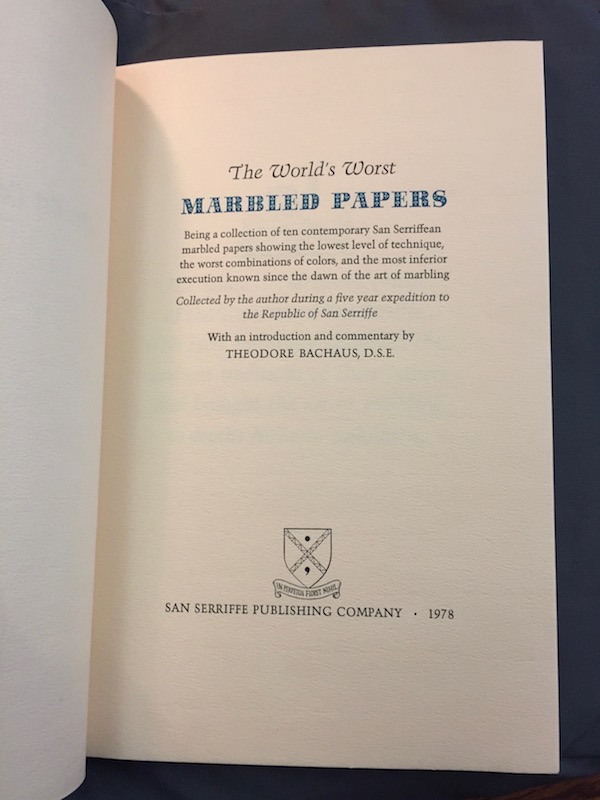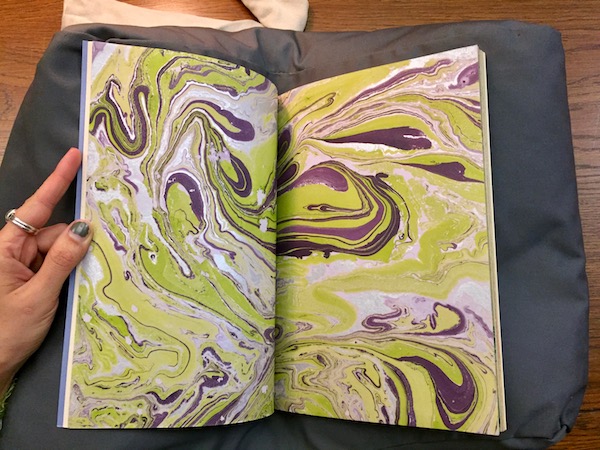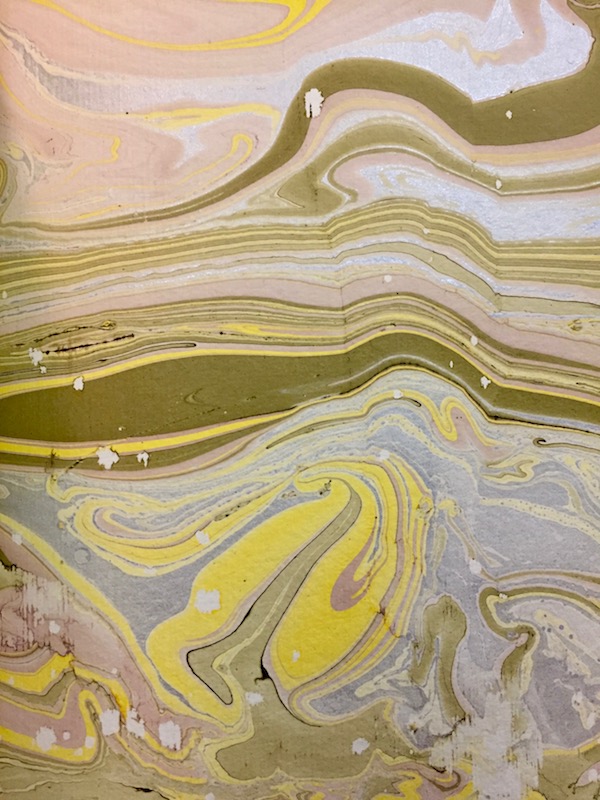
The World's Worst Marbled Papers, Theodore Bachaus [Henry Morris], San Serriffe Publishing Company [Bird and Bull Press], Port Clarendon, S.S. [Newton, PA], 1978. * Z271 .W67 1978. The title page, featuring the colophon of the fictitious San Serriffe Publishing company. The semicolon refers to the purported shape of the island, and the Latin inscription loosely translates to "In perpetual light, nothing flourishes."

The World's Worst Marbled Papers, Theodore Bachaus [Henry Morris], San Serriffe Publishing Company [Bird and Bull Press], Port Clarendon, S.S. [Newton, PA], 1978. * Z271 .W67 1978. This paper is entitled "Bagnio Baroque." Note the haphazard application and irregular manipulation of the ink. In this, and in the following example, a metallic silver ink is used which would have been more expensive and could have increased the price for these papers.

The World's Worst Marbled Papers, Theodore Bachaus [Henry Morris], San Serriffe Publishing Company [Bird and Bull Press], Port Clarendon, S.S. [Newton, PA], 1978. * Z271 .W67 1978. This paper is entitled "Hoi Polloi." Note the blank spots in the pattern, which indicate the presence of air bubbles when the paper was applied to the ink surface. A more skillful or attentive marbler would be able to avoid these flaws.
The World's Worst Marbled Papers, with Introduction and Commentary by Theodore Bachaus [Henry Morris], San Serriffe Publishing Company [Bird and Bull Press], 1978.
This book is a collection of marbled paper samples entitled The World’s Worst Marbled Papers, and while the books' purported provenance is false the assessment of the marbling skill on display is unfortunately not. It is subtitled “Being a collection of ten contemporary San Serriffean marbled papers showing the lowest level of technique, the worst combinations of colors, and the most inferior execution known since the dawn of the art of marbling. Collected by the author during a five year expedition to the Republic of San Serriffe.” The introduction and commentary are provided by a Theodore Bachaus. The book was published in 1978 by the San Serriffe Publishing Company, evidently on letterpress. The book is 18.9 cm by 27.3 cm by 1.6 cm with 30 pages. The signatures are sewn together and then pasted onto a single sheet of blue cardstock weight paper that is folded around the textblock to form the front cover, spine, and back cover. The front cover is blank except for the colophon of the publishing company, a crest featuring a semi-colon and the script “In Perpetua Floret Nihil.” The first page features just the phrase “Ars Est Celare Artem.” The second page is the title page, and features the only use of colored ink in the book: the words “Marbled Paper” in the title are printed in blue ink and in a decorative serif font with small floral patterns in the strokes of the letters. There follows a brief dedication to the “artist-craftsmen of the Republic of San Serriffe,” a three page introduction by Theodore Bachuas, and then the 10 “worst marbled papers.”
Each sample of marbled paper is the complete width and height of the opened book, folded in half so that it spans two facing pages, and bound as a single signature of the text block. Each piece of marbling is also designated a number and a title, printed on the back of the sample in the lower right hand corner so that is read before turning the page to view the actual marbling. Some examples of these titles are “Bagnio Baroque,” “Late Vey-Izmir,” “Large Hibachi,” and “Hoi Polloi.” After all the samples there a page titled “An explanation of the origin of the San Serriffe patterns, all of which are of strictly local derivation,” which lists each numbered title alongside a brief description of its artistic and historical provenance. The final printed page of the book carries a note on the publishing and acknowledgments. It states that publishing was done in “Port Clarendon, S.S. in July, 1978” and that 400 copies were made, this edition being the first. Thanks are given to “the artists of San Serriffe and Big Wally’s Cut Rate Rare Books, Ltd.” The final three pages of the book are blank.
Now for the twist. There is no country of San Serriffe and there is no Theodore Bachaus! This book was actually published by Bird and Bull Press, owned and operated by Henry Morris and one of the oldest private presses in America. Bird and Bull was founded in 1958, when Morris’s hobby for paper-making inspired him to begin publishing texts on subjects pertaining to book-making, including printing, illustration, book binding, and typography. In 2008, the American Printing History Association bestowed on him their annual award for “distinguished contribution to the study, recording, preservation or dissemination of printing history,” acknowledging that “without the Bird & Bull, many books on worthwhile, albeit esoteric subjects would probably never have been published.” Bird and Bull’s books were all published by letterpress from metal type and most on Morris’s own handmade paper. The press closed in 2013, citing Morris’s advanced age and “increasing difficulty in finding exciting and interesting book projects.”
The World’s Worst Marbled Papers was born when Morris received a bulk order of remarkably cheap marbled papers from the firm Mer Cie. A friend commented that they were the worst pieces he had ever seen. Morris found a use for them, under the ironic guise of the “positive virtue in inferiority, when brought to its absolute lowest and most abysmal degree.” He published them pseudonymously, using for his cover the infamous “San Serriffe” prank played by The Guardian newspaper. On April Fools Day, 1977, the Guardian ran a 7-page travel supplement on “San Serriffe,” an tropical island republic in the shape of a semi-colon. Many of the island’s features were puns on typographic terms: the capital of “Bodoni,” the cities of “Garamondo” and “Perpetua,” and the coastline of “Gill Sands.” The hoax was massively popular spawning many knowing tributes as well as confused letters to the editorial staff. Morris’s contribution to the hoax spanned decades with the printing additional ephemera related to the San Serriffe Publishing Company, including fake visitors badges to San Serriffe paper mills, letters from Theodore Bachaus, and a monograph on San Serriffean booksellers.
Despite its satirical premise, The World’s Worst Marbled Papers is a noteworthy inclusion to a study on the arts of book and paper making. Paper marbling, or the printing technique of floating ink designs on water, is thought to originate in Japan in the 12th century as a method for dying fabric. It is in Turkey in the 15th century when marbled paper is first seen as a decorative element in book arts and illustration. In the following three centuries the craft gains traction in Europe, traveling slowly north from the Mediterranean and now used consistently in printing, binding, and embellishing books. The relatively slow spread of marbling traditions across Asia and Europe is attributed not only to the difficulty of obtaining proper materials and perfecting the craft, but to the secrecy perpetually surrounding the details of marbled paper production. It was not until the late 19th century that some of the first manuals on paper marbling were published in England, and artist/authors such as Charles Woolnough and James Sumner were criticized by artisan guilds for openly teaching and publishing. However, it is from these authors that many contemporary books on marbled paper, take their inspiration: they are frequently elegant productions that highlight the artistry of book and paper making, containing detailed instructions on the craft and many fine examples of regional techniques and patterns.
Morris dramatically subverts this tradition in his publishing of The World’s Worst Marbled Papers. While the book is carefully designed and masterfully printed, the marbled papers are mediocre at best and presented for humors’ sake, rather than artistry. Marbled paper may have an esteemed history but Morris’s book proves that there is also plenty of humor and kitsch to be found in fine art bookmaking.
References
April fool - San Serriffe: teaching resource of the month from the GNM Archive: Elli Narewska, The Guardian.
The Art of Marbled Paper: Dynamic Fluids in Flow: Yana van Dyke, The Metropolitan Museum of Art.
Decorated Papers. University of Washington, Historical Books Arts Collection.
Goodbye to the Wonderful Bird & Bull Press. Princeton University Library Graphic Arts Collection.
Henry Morris: Jane Rodgers Siegel, American Printing History Association.
Henry Morris and the Bird and Bull Press: Ashley Jones, Miami University Libraries Steward & Sustain Department.
Henry Morris, Printer: The Life and Times of Bird and Bull Press: Alexander Johnston, The University of Delaware Library Special Collections.
Marbled Paper: Its History, Techniques, and Patterns: Richard J. Wolfe, University of Pennsylvania Press
This spotlight exhibit was written by Isabelle Briggs as part of Dr. Johanna Drucker's "History of the Book and Literacy Technologies" seminar in Winter 2018 in the Information Studies Department at UCLA.
For documentation on this project, personnel, technical information, see Documentation. For contact email: drucker AT gseis.ucla.edu.